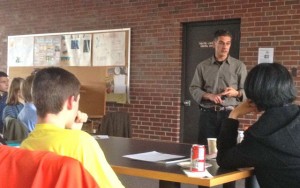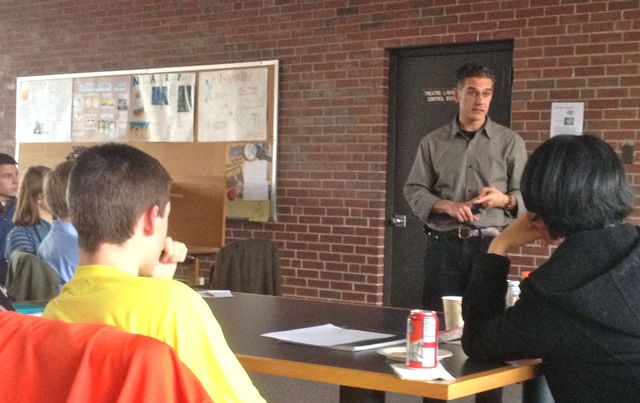An outbreak of fungal meningitis. That’s the problem that University of Massachusetts Professor of Chemistry Dr. Scott Auerbach asked AP Integrated Science students to solve when he visited The Williston Northampton School on November 15.
As the students settled into groups of three and four, Auerbach outlined the grim statistics: 438 cases in 19 states with a death total of at least 32.
“Today’s goal is to understand the role science plays in making sense of understanding this outbreak,” Auerbach said. “Your job is to be Beth Bell, the director of the National Center for Emerging and Zoonotic Infectious Diseases.”
This was one problem that the students weren’t going to be able to solve by looking in the back of their textbook—and not being able to immediately find the solution is the point. When Science Department Chair Bill Berghoff put together the pilot program for the integrated science class, his aim was to encourage collaboration and scientific creative thinking.
“I’m really big into inquiry-based learning,” he said. “You have to do experiments, you have to do activities, to really understand what’s going on.”
Students enrolled in an AP course—biology, chemistry, physics, environmental science, or psychology—can apply to take the integrated science class, which focuses on discussing, developing, and implementing plans to solve current global issues.
The class is modeled after a similar program at the University of Massachusetts at Amherst, called Integrated Concentration in Science (iCons). In the UMass program, students from across disciplines come together to work on case studies such as the cholera outbreak in Haiti, the correlation between aluminum consumption and Alzheimer’s disease, and measuring the oil spilled in the Gulf of Mexico.
“It’s rare to get to work on problems head on—that’s the point of iCons,” Auerbach, the iCons program director, told the Williston students. He added that instead of opening up a textbook, his students were opening up their newspapers.
“The only way to get experience is to practice tackling big problems,” Auerbach said. “You have to figure out what questions to ask.”
In their bi-monthly meetings throughout the coming year, the 10 Williston students will split into groups to work on similar case studies. They’ll also hear presentations from iCons faculty—starting with Auerbach and Chaz Nielson, the program’s mentor coordinator.
At the end of the year, after they have completed their AP tests, the students will meet more frequently and will develop group presentations of their own.
It’s a format that appeals to students such as Matt Cavanaugh ’14 and Hannah Lewis ’13. Both said they look forward to trying to solve problems that don’t yet have a solution.
“I’ve always known I wanted to help solve big problems,” Cavanaugh said after class. “This prepares us in a more hands-on way.”
“It’s really exciting,” Lewis agreed. “When we get out of Williston we won’t be reading textbooks our whole lives. We’ll be getting out and solving problems.”



What a program and opportunity for our students! Congratulations to everyone involved in the creation and pursuit of this innovative approach to education at WNS. By challenging students to cooperatively tackle real world problems, you are truly preparing our kids to be capable and careful caretakers of the future. Carry on and keep us posted!